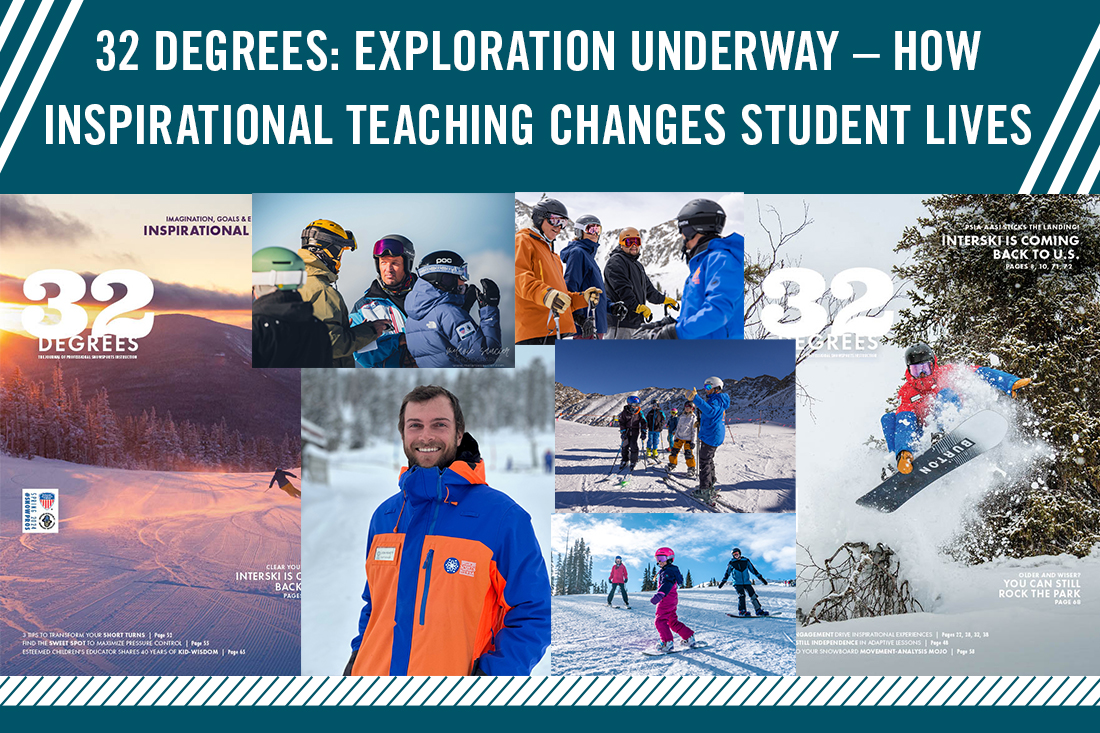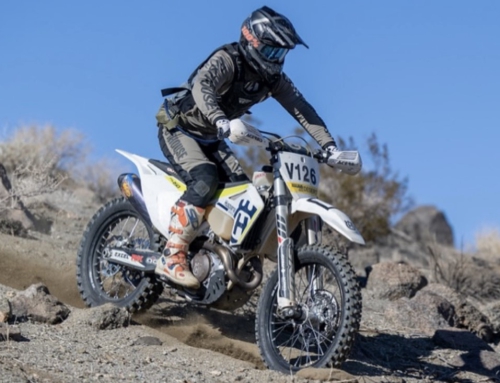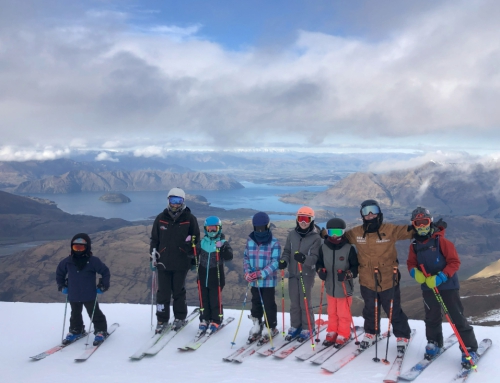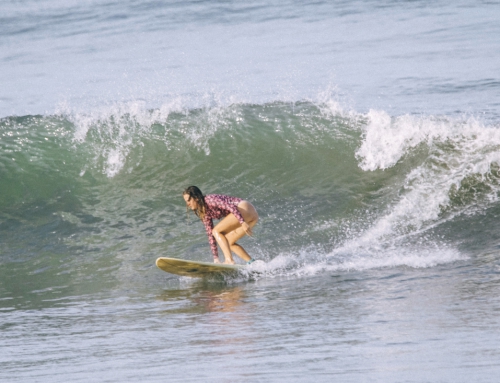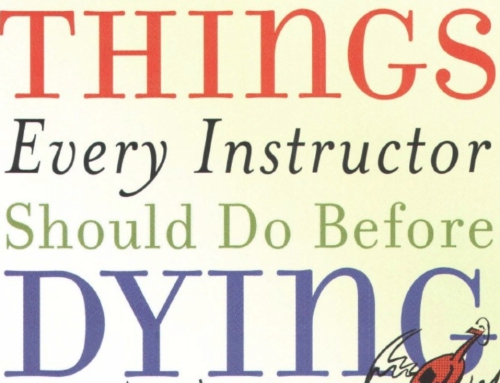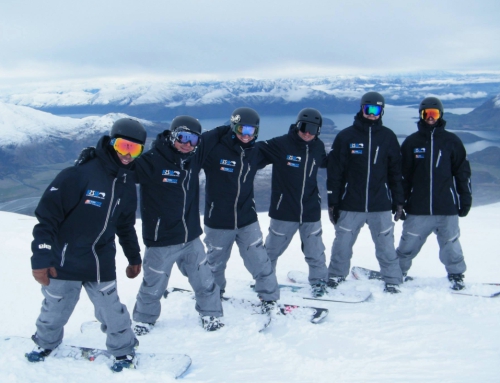32 Degrees: Exploration Underway – How Inspirational Teaching Changes Student Lives
This story by Peter Kray appears in the Spring 2024 Issue of 32 Degrees. You can read the entire issue by visiting the 32 Degrees page on our website.
In iconic sports movies like Miracle (about the 1980 gold medal-winning U.S. Olympic Hockey Team) and Remember the Titans (about a race barrier-breaking Virginia high school football team), the penultimate scenes involve athletes reaching their loftiest goals when they finally embrace the lessons and inspiration they have received from their coaches.
It makes for magic on the screen. But what if that same thrilling, day-changing breakthrough could happen in every ski and snowboard lesson?
Several PSIA-AASI education leaders are exploring that very possibility, in a method of instruction they are calling “Inspirational Teaching.”
“Simply put, inspirational teaching is that which opens students’ eyes to new possibilities and supports their growth toward a new potential,” said Josh Pighetti, a Level II alpine instructor and Level I snowboard and adaptive instructor at Mammoth Mountain, California. Pighetti is also a Ph.D. candidate at Penn State University in the College of Health and Human Development, where he is conducting research to gain a deeper understanding of perspectives on inspirational instruction within the context of the snowsports industry.
“The question that has been most intriguing to me is how inspirational teaching happens,” Pighetti said. “Looking into other areas of education, inspirational educators are experts in their field who teach with strong passion and empathy. When teaching, they create an environment that makes students feel welcomed, involved, and safe.” Pighetti added that research into how snowsports instructors inspire can reveal ways to develop and enhance their skills and behaviors to inspire students to continue learning and engaging in snowsports.
He said the idea for “inspirational instruction” came to him during a conversation with Pete Allison, Ph.D. – his advisor at Penn State. Allison is associate professor in values and experiential learning in the university’s Department of Recreation, Park, and Tourism Management, and is collaborating with PSIA-AASI to develop the recently launched Certificate in Professional Snowsports Education program.
“Pete and I wanted to gain a greater understanding of how instructors most impactfully contribute to success and longevity in snowsports,” Pighetti said. “What do instructors provide? Motivation crossed my mind, but that’s been researched plenty and is already covered in PSIA-AASI materials. With substantial information on motivation available, I began to wonder what comes before motivation. We arrived at inspiration as a concept that has the potential to instill motivation.”
NO LESSON IS THE SAME
Pighetti has been developing a broader body of knowledge on the concept with other instructors, including PSIA Alpine Team members Mike Hafer and Zoe Mavis and AASI Snowboard Team member Matt Larson.
“I’ve enjoyed working with Josh on this topic because it brought out some interesting points of inspirational teaching and how we positively affect a learning environment,” said Hafer. “Since the 2023 National Academy in Big Sky, Montana, I’ve been reflecting on what I specifically do when my clinics are successful, meaning that everyone goes away with their goals being met.”
He said he’s been thinking about three key areas of lesson structure:
- How do instructors engage everyone in the group?
- How do we keep each lesson fun, and what does that mean for each participant?
- How do we share knowledge? Knowledge is power, and the more simply we can share it, the more successful each lesson can be.
“All of this starts the moment you first meet your students or people taking your clinic. You have to make a point to welcome them into the environment and let them know that what you want to accomplish is for their benefit,” Hafer said. “I make sure that I know everyone’s first names and go around the horn and make eye contact and call them by their first names. It sounds simple, but it sets the stage for how much everyone matters, and that this is an experience we are going to share.”
He also makes sure he understands each person’s goals – whether that’s racking up 30,000 feet of vertical or really going in depth on how to make those carved short-radius turns they want to master.
As for keeping it fun, Hafer said, “That’s the million-dollar question. It has a different meaning for everyone. The only way to identify someone’s ‘fun goal’ is to ask them. To me, it’s the same as considering how you engage people. The more you talk with them and get to know them – on the chair and on the run – the more you will understand.”
Hafer added that the most important element to inspirational teaching, though, is to be prepared to find a way to meet your students’ needs in real time, and not show up with a lesson plan that is stale or canned. “You can’t just roll out the same mundane progression,” Hafer said. “That gets a little flat. You have to embrace the moment. That’s where the inspiration happens.”
IT’S ABOUT EMOTION
Ask Matt Larson what makes a lesson “inspirational,” and he’ll tell you it’s a mixture of energy and emotion.
“Inspirational teaching ties back to how we form memories according to the emotional component, when a person can feel valued and significant,” he said. “Those are the things that are going to stay with them. I think it triggers some of that dopamine in the brain – that’s the drug that’s going to bring them back to the sport again and again.”
Larson said that people are more likely to remember events – or lessons – if they evoke strong emotions. “It’s about creating a connection with people in a way that they know you are invested in their success,” he noted.
“At its most basic element, there’s a sense of gratitude that people shared their time to take your clinic or lesson,” said Larson. “You are recognizing that we all have some skin in the game, and together we can create this incredible experience that we all worked together to make happen.”
“I think there’s this key moment,” he said, “Where you are acknowledging that these individuals decided to spend their time with you. It’s their lesson. Your goal is to make sure you create a meaningful experience for them.”
WHAT IS INSPIRATIONAL?
Zoe Mavis agrees and says one of the keys for her is defining exactly what her students or clinicians might find inspiring.
“We use the word ‘inspiration’ a ton in our industry,” Mavis said. “But what am I inspiring people to do? Do I want them to become lifelong skiers, improve their skiing, or come back to a place because they had such a good experience there the first time? If you want to deliver an experience that inspires someone to do something, you need to understand what their needs are, and that starts with information gathering.”
Like Larson, Mavis said she finds that the people she skis with are more likely to remember their on-snow experience by recalling who was there and what they learned.
“When you have that inspirational experience, it’s almost always because you shared it with someone,” she said. “That sense of community, of exceptional moments, or achieving shared goals is how you can relate it to someone else. There’s this connection to the sport, the experience, the environment, that you would never have had if you hadn’t taken this lesson. You just had this beautiful day you never would have had if you didn’t go out skiing or snowboarding with this person.”
“This whole idea,” she added, “is about creating experiences people never could have created on their own.”
Gathering insight into inspiration could drive the next breakthrough instructional concept that informs how PSIA-AASI members create magical experiences for their students. Josh Pighetti and his snowsports colleagues are eager to see – and share – how inspirational teaching can make for magic on snow. Stay tuned for more to come on this important topic.
Peter Kray is the lead writer for PSIA-AASI, focusing on emerging ski and snowboard trends, education, and on-snow innovation. He skis and telemarks out of Santa Fe, New Mexico, and is the author of American Snow and The God of Skiing. | pkray@psiaprodcms.azurewebsites.net
